- Clone
- SA275A11 (See other available formats)
- Regulatory Status
- RUO
- Other Names
- Ms4a1, Ly-44
- Isotype
- Rat IgG2b, κ
- Barcode Sequence
- TCCACTCCCTGTATA
| Cat # | Size | Price | Quantity Check Availability | ||
|---|---|---|---|---|---|
| 150427 | 10 µg | $369.00 | |||
CD20 is a 33-37 kD protein, a member of the MS4A family, with four transmembrane spanning regions that present as a homo-oligomeric complexes in the cell surface when associating with MHC class I and II, CD53, CD81, and CD82. CD20 is expressed on B cells and a subset of T cells, but not on plasma cells. CD20 regulates B-cell activation and proliferation. Its ligation promotes transmembrane Ca2+ trafficking. CD20 is an important therapeutic target in the treatment of B cell lymphomas and leukemias.
Product Details
- Verified Reactivity
- Mouse
- Antibody Type
- Monoclonal
- Host Species
- Rat
- Immunogen
- Mouse CD20 - transfected cells
- Formulation
- Phosphate-buffered solution, pH 7.2, containing 0.09% sodium azide and EDTA
- Preparation
- The antibody was purified by chromatography and conjugated with TotalSeq™-C oligomer under optimal conditions.
- Concentration
- 0.5 mg/mL
- Storage & Handling
- The antibody solution should be stored undiluted between 2°C and 8°C. Do not freeze.
- Application
-
PG - Quality tested
- Recommended Usage
-
Each lot of this antibody is quality control tested by immunofluorescent staining with flow cytometric analysis and the oligomer sequence is confirmed by sequencing. TotalSeq™-C antibodies are compatible with 10x Genomics Chromium Single Cell Immune Profiling Solution.
To maximize performance, it is strongly recommended that the reagent be titrated for each application, and that you centrifuge the antibody dilution before adding to the cells at 14,000xg at 2 - 8°C for 10 minutes. Carefully pipette out the liquid avoiding the bottom of the tube and add to the cell suspension. For Proteogenomics analysis, the suggested starting amount of this reagent for titration is ≤ 1.0 µg per million cells in 100 µL volume. Refer to the corresponding TotalSeq™ protocol for specific staining instructions.
Buyer is solely responsible for determining whether Buyer has all intellectual property rights that are necessary for Buyer's intended uses of the BioLegend TotalSeq™ products. For example, for any technology platform Buyer uses with TotalSeq™, it is Buyer's sole responsibility to determine whether it has all necessary third party intellectual property rights to use that platform and TotalSeq™ with that platform. - Additional Product Notes
-
TotalSeq™ reagents are designed to profile protein levels at a single cell level following an optimized protocol similar to the CITE-seq workflow. A compatible single cell device (e.g. 10x Genomics Chromium System and Reagents) and sequencer (e.g. Illumina analyzers) are required. Please contact technical support for more information, or visit biolegend.com/totalseq.
The barcode flanking sequences are CGGAGATGTGTATAAGAGACAGNNNNNNNNNN (PCR handle), and NNNNNNNNNCCCATATAAGA*A*A (capture sequence). N represents either randomly selected A, C, G, or T, and * indicates a phosphorothioated bond, to prevent nuclease degradation.
View more applications data for this product in our Scientific Poster Library. - RRID
-
AB_2860716 (BioLegend Cat. No. 150427)
Antigen Details
- Structure
- Member of the MS4A family, four transmembrane spanning regions, three isoforms of 37, 35, and 37 kD, depending on the phosphorylation degree.
- Distribution
-
B cells and a subset of T cells.
- Function
- Regulates B-cell activation and proliferation.
- Interaction
- Associated with MHC class I and II, CD53, CD81, and CD82.
- Cell Type
- B cells, T cells
- Biology Area
- Costimulatory Molecules, Immunology
- Molecular Family
- CD Molecules
- Antigen References
-
1. Morsy DE, et al. 2013. J. Immunol. 191:3112.
2. Lund FE, Randall TD. 2010. Nat. Rev. Immunol. 10:236.
3. Beers SA, et al. 2010. Blood 115:5191.
4. Kuijpers TW, et al. 2010. J. Clin. Invest. 120:214. - Gene ID
- 12482 View all products for this Gene ID
- UniProt
- View information about CD20 on UniProt.org
Other Formats
View All CD20 Reagents Request Custom Conjugation| Description | Clone | Applications |
|---|---|---|
| Alexa Fluor® 647 anti-mouse CD20 | SA275A11 | FC,IHC-F |
| Brilliant Violet 421™ anti-mouse CD20 | SA275A11 | FC,IHC-F |
| FITC anti-mouse CD20 | SA275A11 | FC |
| PE anti-mouse CD20 | SA275A11 | FC |
| APC anti-mouse CD20 | SA275A11 | FC |
| Biotin anti-mouse CD20 | SA275A11 | FC |
| Alexa Fluor® 700 anti-mouse CD20 | SA275A11 | FC |
| APC/Cyanine7 anti-mouse CD20 | SA275A11 | FC |
| PE/Cyanine7 anti-mouse CD20 | SA275A11 | FC |
| PerCP/Cyanine5.5 anti-mouse CD20 | SA275A11 | FC |
| TotalSeq™-A0192 anti-mouse CD20 | SA275A11 | PG |
| TotalSeq™-B0192 anti-mouse CD20 | SA275A11 | PG |
| TotalSeq™-C0192 anti-mouse CD20 | SA275A11 | PG |
| KIRAVIA Blue 520™ anti-mouse CD20 Antibody | SA275A11 | FC |
| PE/Dazzle™ 594 anti-mouse CD20 Antibody | SA275A11 | FC |
| Alexa Fluor® 488 anti-mouse CD20 Antibody | SA275A11 | FC |
| Brilliant Violet™ 605 anti-mouse CD20 | SA275A11 | FC |
| APC/Fire™ 810 anti-mouse CD20 | SA275A11 | FC |
Compare Data Across All Formats
This data display is provided for general comparisons between formats.
Your actual data may vary due to variations in samples, target cells, instruments and their settings, staining conditions, and other factors.
If you need assistance with selecting the best format contact our expert technical support team.
-
Alexa Fluor® 647 anti-mouse CD20
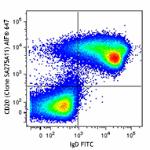
C57BL/6 mouse splenocytes were stained with IgD FITC and CD2... 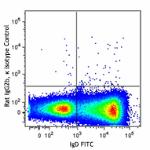
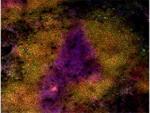
C57BL/6 mouse frozen spleen section was fixed with 4% parafo... -
Brilliant Violet 421™ anti-mouse CD20
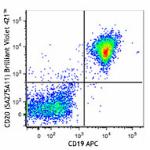
C57BL/6 mouse splenocytes were stained with CD19 APC and CD2... 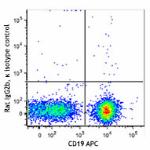
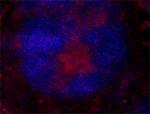
C57BL/6 mouse frozen spleen section was fixed with 4% parafo... -
FITC anti-mouse CD20
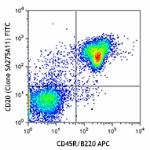
C57BL/6 mouse splenocytes were stained with CD45R/B220 APC a... 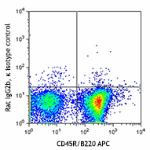
-
PE anti-mouse CD20
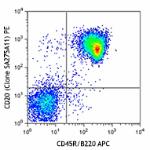
C57BL/6 mouse splenocytes were stained with CD45R/B220 APC a... 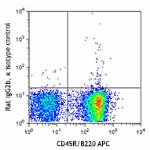
-
APC anti-mouse CD20
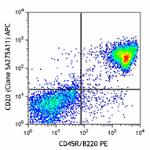
C57BL/6 mouse splenocytes were stained with CD45R/B220 PE an... 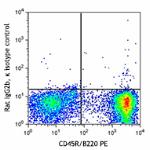
-
Biotin anti-mouse CD20
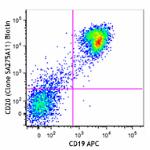
C57BL/6 mouse splenocytes were stained with CD19 APC and bio... 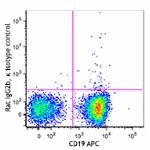
-
Alexa Fluor® 700 anti-mouse CD20
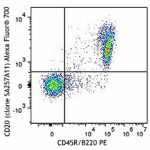
C57BL/6 mouse splenocytes were stained with CD45R/B220 PE an... 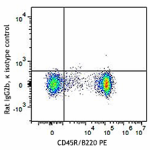
-
APC/Cyanine7 anti-mouse CD20

C57BL/6 mouse splenocytes were stained with CD45R/B220 FITC ... -
PE/Cyanine7 anti-mouse CD20

C57BL/6 mouse splenocytes were stained with CD45R/B220 FITC ... -
PerCP/Cyanine5.5 anti-mouse CD20

C57BL/6 mouse splenocytes were stained with CD45R/B220 FITC ... -
TotalSeq™-A0192 anti-mouse CD20
-
TotalSeq™-B0192 anti-mouse CD20
-
TotalSeq™-C0192 anti-mouse CD20
-
KIRAVIA Blue 520™ anti-mouse CD20 Antibody

C57BL/6 mouse splenocytes were stained with CD45R/B220 APC a... -
PE/Dazzle™ 594 anti-mouse CD20 Antibody

C57BL/6 mouse splenocytes were stained with CD45R/B220 APC a... -
Alexa Fluor® 488 anti-mouse CD20 Antibody

C57BL/6 mouse splenocytes were stained with CD45R/B220 APC a... -
Brilliant Violet™ 605 anti-mouse CD20

C57BL/6 mouse splenocytes were stained with anti-mouse/human... -
APC/Fire™ 810 anti-mouse CD20

C57BL/6 mouse splenocytes were stained with anti- mouse CD45...
